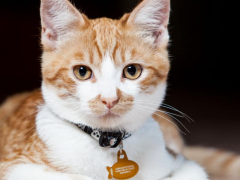
One of the more stressful aspects of being a cat owner is when we see our precious pets get hurt. However, it can sometimes be difficult to know when a wounded cat has an injury that is more serious.
Wounded cats, especially ones with open wounds, will often hide as a natural response to conceal their vulnerability from predators. Cats are also experts at hiding signs of pain, which can lead to an injury seeming more minor than it really is.
Some minor cuts and abrasions on your cats are suitable for home treatment, but large, open wounds, lacerations, and bite wounds will usually require veterinary attention. In this guide, we will discuss what to look for when determining the severity of wounds on a cat, when basic first-aid that you can administer at home is appropriate, and when a visit to the veterinarian may be necessary.
Types Of Wounds
1. Small Scrapes
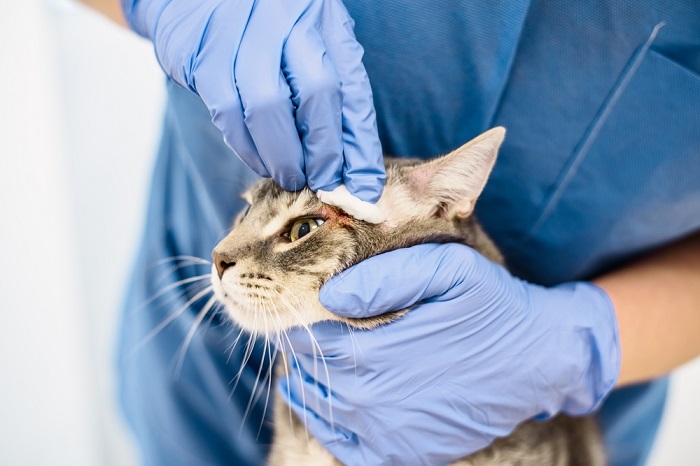
Keeping a cat’s open wounds clean is necessary for faster and smoother healing.
Minor injuries such as skin abrasions, superficial cuts, and grazes are usually suitable for treatment at home. Keep the area clean by bathing it twice daily, if your cat will allow this. Use warm water or saline solution and a clean cloth. If the wound is dirty, seek advice from a veterinarian rather than using any type of disinfectant or antiseptic.
Keep wounds clean, dry, and open to the air. Avoid creams or ointments unless directed by a vet. Monitor your wounded cat carefully for any signs of infection, such as redness, swelling, discharge, or a bad odor.
Also Read: How To Clean A Cat Wound
2. Lacerations
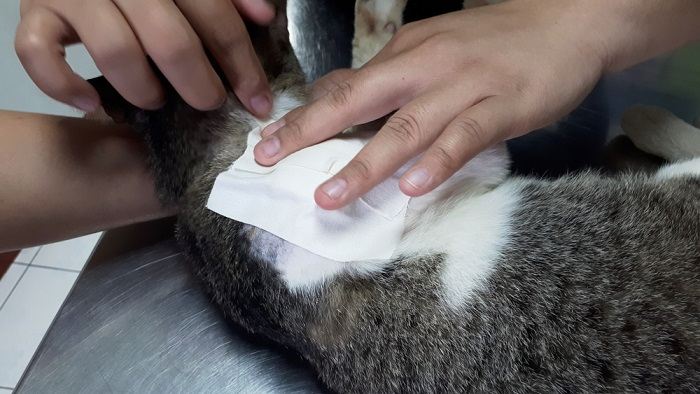
Lacerations on cats can be easy to miss in their fur and require careful attention.
Deeper cuts can be difficult to spot, as the wound edges often cover the underlying tissues. A cat wound that is bleeding, sore, and potentially deep will need to be assessed by a veterinarian. Cover the wound with sterile gauze to protect it and hold pressure on it if it’s bleeding. Your vet will be able to clean and assess the wound and decide on the best way to encourage the healing process.
Some wounds may need sutures, while others are better left to heal via granulation. Deep lacerations are more at risk of wound infections, and your vet may dispense medications such as antibiotics and pain relievers. Surgically closed wounds must be kept clean and dry, and your cat may need to be kept in an enclosed area to prevent them from moving around too much.
Also Read: Do Cats Get Headaches?
3. Bite Wounds
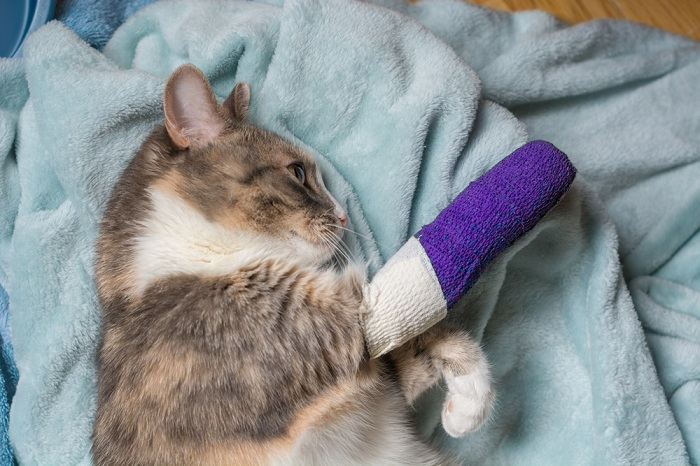
Bite wounds can easily lead to nasty infections, and need to be dealt with quickly.
Fighting between cats is not uncommon, especially in densely populated areas. Puncture wounds caused by a bite (or even a cat scratch) are often deeper than they look, and nearly always become infected if left alone.
Abscesses are common with bite wounds and may need more intensive antibacterial treatment, such as flushing, surgical debridement, and antibiotics. Any bite injury should always be assessed by a vet, and snake bites should be seen as a matter of urgency.
Also Read: Cat Bite Infection: Causes, Symptoms & Treatment
4. Large Wounds
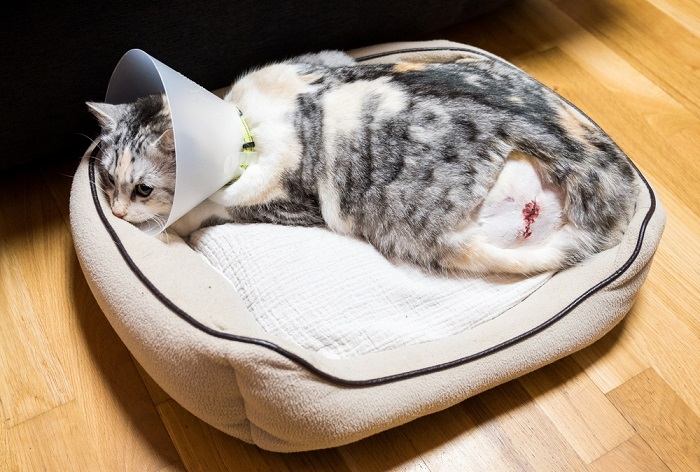
If your cat suffers from a large wound, be patient. The healing process can be involved and take time.
More severe wounds need more time and management to heal. There are often secondary complications such as blood loss and infection that may need treatment first before the wound can be repaired.
Larger wounds are likely to be painful, and your cat may need to stay at the vet’s for sedation or anesthesia for the wound to be treated. Sutures, dressings, and bandages may all be used to manage the injury and it may take considerable time to heal. Large, deep lacerations can leave scars.
Also Read: What Can You Give A Cat For Pain? 6 Vet-Recommended Options
When A Wound An Emergency
The vast majority of wounds in cats will need to be assessed by a veterinarian and undergo some form of treatment. But how urgently do they need to be seen? There are a few scenarios in which veterinary attention should be sought without delay.
- Burns
- Eye injuries
- Wounds with an object lodged in them, such as a glass shard. These are often sharp objects and should not be removed, but left alone for the veterinarian to manage.
- Bleeding – a small amount of oozing is manageable with a sterile pad and some pressure, but if a cut continues to drip, or even gush with blood, urgent help should be at a veterinarian should be sought out.
- Large wounds – injuries larger than the size of a coin should be seen by a vet. The prognosis for good healing and no infection is highest if wounds are seen quickly.
Smaller lacerations, dirty wounds, bites, and infected injuries all also need to be seen by a veterinarian but are not classed as an absolute emergency.
Also Read: Why Do Cats Lick And Clean Themselves?
How You Can Help Your Wounded Cat
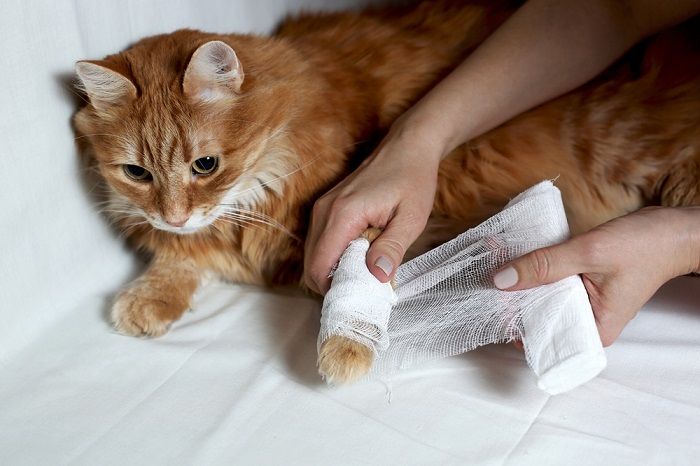
A calm, gentle approach to caring for a wounded cat is best, as cats react defensively when they are stressed.
If you have a wounded cat, try to remain calm. Your pet may well be in pain and distress, which can lead to them hiding away or even expressing aggression and other defensive behaviors. Try and assess the wound as best you can, and call your veterinarian if you need to attend the clinic. Cats can be safely restrained by wrapping them in a towel and holding them gently but firmly so that they cannot move around too much.
Here are some basic first-aid procedures that you can perform to help your cat while awaiting a veterinary assessment.
- If the wound is bleeding, cover it with something clean and hold pressure on it. Ideally, a sterile dressing should be used, but a clean dish towel is a good alternative. Keep the pressure firm and do not change the cloth, but keep holding it on the wound even if you think the bleeding has stopped.
- If there is an object in the wound, do not move it. If the wound is contaminated with dirt, do not attempt to clean it with any substance, including chlorhexidine. If the wound is very superficial, it can be washed with water and a clean cloth. Anything more major should be seen by a vet.
- Run cold water over burns if safe to do so and it is tolerated by the cat. This should not delay veterinary treatment.
If you are unsure whether an injury requires veterinary attention, it is usually best to take your cat to the veterinarian just to be on the safe side. You can also call your vet for some advice.
Also Read: Why Do Kittens Bite? How To Properly Handle Kitten Aggression
Injuries in pets can be difficult to assess, as cats can be uncooperative when in pain or distress, and their thick coats can obstruct a good view. Minor cuts and scrapes on a wounded cat can be treated at home by keeping them clean and open, but dirty, contaminated, infected and more major wounds must receive veterinary attention.
Also Read: How To Keep Your Cat From Jumping After Surgery


